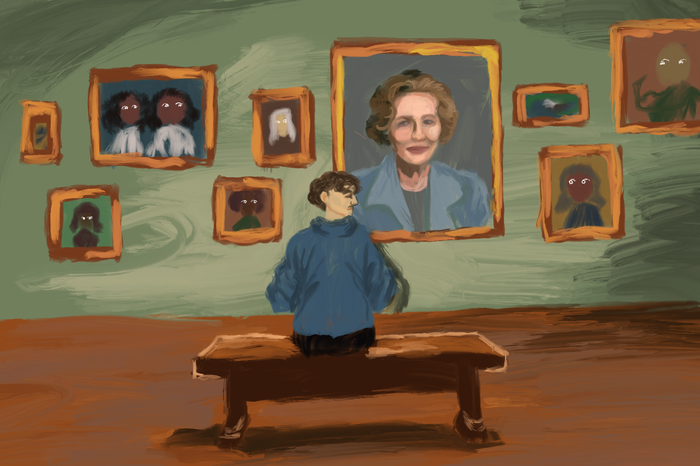The theft of women’s art
Emma Tenzler explores the stories of women whose art was taken from them and reused by their male counterparts

The theft of art is a theft of identity. Female artists have had their art appropriated and sabotaged by male partners, husbands, collaborators, and teachers, time and time again. This century-long theft has amounted to the erasure of the identity of women in the history of art. By failing to acknowledge the contributions and creations of female writers, painters, poets, and sculptors, this history serves the men who stole and fails the women who were robbed of their creativity and their legacy.
“The theft of art is a theft of identity”
The writer, dancer, and painter Zelda Fitzgerald, born Sayre, is known to us through the narrative created by her husband in fiction, and in life: “I hope she’ll be a fool! That’s the best thing a girl can be in this world, a beautiful little fool,” says Daisy Buchanan in the Great Gatsby (1925). But Zelda, who first penned these words after the birth of her daughter in 1921, was no fool. “On one page I recognized a portion of an old diary of mine which mysteriously disappeared shortly after my marriage, and, also, scraps of letters which… sound to me vaguely familiar,” she told The New Yorker about her husband’s novel, The Beautiful and Damned (1922). When her only published novel, Save Me the Waltz (1932), took the liberty of exploring her life on her own terms, an enraged F. Scott Fitzgerald edited it into a totally unrecognisable state. In 1932, he accused his wife of plagiarism. Two years later, he (re)used her material in his novel Tender is the Night (1932). Zelda died writing. Her last, unfinished novel Caesar’s Things survived the fire that ended her life in the mental hospital into which she had been committed since 1948. As Heather Laine Talley wrote, “his [F. Scott Fitzgerald’s] work depended on Zelda’s silence”. Her artistic voice demanded that this silence be broken.
“This century-long theft has amounted to the erasure of the identity of women in the history of art”
German writer, translator, and actress Margerete Steffin was no stranger to silence. To call her relationship with dramatist Bertolt Brecht one of “collaboration” betrays her literary genius. Brecht scholar John Fuegi has shown that eight of Brecht’s most seminal plays, including Mother Courage and her Children, and The Life of Galileo, were the product of her imagination and of her pen. Steffin’s handwriting graces the pages of the manuscripts of the plays that incorporate translations from the French language that Brecht never mastered. The “Brecht collective” strategically exploited the creativity and dedication of the women in Brecht’s life, as writers Ruth Berlau and Elizabeth Hauptmann (who authored The Threepenny Opera) similarly saw their work stolen and contribution left unacknowledged. Margarete Steffin’s life was taken by tuberculosis while she awaited the American visa that would reunite her with the man who had abandoned her in the Soviet Union. Bertolt Brecht, in life and in artistry, realised his view that “the man can demand a tremendous amount, and the woman must give a tremendous amount”.
French sculptor Camille Claudel suffered the costs of this taking when she refused to give. The artistic collaboration with her famed teacher Auguste Rodin saw the latter create some of his greatest work. Claudel´s contribution to pieces such as the monumental Burghers of Calais (she sculpted the hands and feet) has been recognized. But some of her sculptures, made dependent on Rodin’s name, continue to bring him adulation. The end of their artistic and romantic relationship in 1892 placed an additional burden in the way of Claudel. Upon seeing a version of her harrowing sculpture The Mature Age in 1899, an enraged Rodin pressured the Ministry of Fine Arts to cancel its funding for the piece. The sculpture depicts a young woman grasping on her knees for the hand of an older man as he is pulled away by another woman. Biographical and allegorical interpretations have been proposed. But another reading offers itself: female artists, forced into dependency and dependent on exploitation, grasping for the acknowledgment they deserve.
Female artists continue to struggle for recognition. The first major solo exhibition in London’s National Gallery of a woman’s art was staged in 2020 and spotlighted the work of Artemisia Gentileschi. Contemporary female artists are still grossly under-represented in North American and European galleries at 13.7%, as research by the National Museum of Women in the Arts has shown.
The works of Camille Claude, Zelda Fitzgerald, Margarete Steffin, and countless other women, named and unnamed, demand the scrutinizing of canonical artworks to uncover the contribution of wives, lovers, students, and workers, as much as the rediscovery of the great work of female artists past and present. Only then can the false remembrance of art history be corrected, and credit be given where it is long overdue.
Want to share your thoughts on this article? Send us a letter to letters@varsity.co.uk or by using this form.
 Comment / Cambridge’s tourism risks commodifying students18 April 2025
Comment / Cambridge’s tourism risks commodifying students18 April 2025 News / Cambridge student numbers fall amid nationwide decline14 April 2025
News / Cambridge student numbers fall amid nationwide decline14 April 2025 News / Greenwich House occupiers miss deadline to respond to University legal action15 April 2025
News / Greenwich House occupiers miss deadline to respond to University legal action15 April 2025 Comment / The Cambridge workload prioritises quantity over quality 16 April 2025
Comment / The Cambridge workload prioritises quantity over quality 16 April 2025 Sport / Cambridge celebrate clean sweep at Boat Race 202514 April 2025
Sport / Cambridge celebrate clean sweep at Boat Race 202514 April 2025





